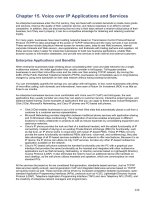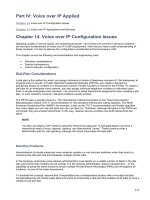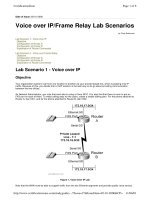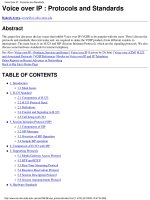Implementing Voice Over IP
Bạn đang xem bản rút gọn của tài liệu. Xem và tải ngay bản đầy đủ của tài liệu tại đây (7.24 MB, 225 trang )
IMPLEMENTING VOICE OVER IP
Copyright 6 2003 by John Wiley & Sons, Inc. All rights reserved.
Published by John Wiley & Sons, Inc., Hoboken, New Jersey.
Published simultaneously in Canada.
No part of this publication may be reproduced, stored in a retrieval system, or transmitted in any
form or by any means, electronic, mechanical, photocopying, recording, scanning, or otherwise,
except as permitted under Section 107 or 108 of the 1976 United States Copyright Act, without
either the prior written permission of the Publisher, or authorization through payment of the
appropriate per-copy fee to the Copyright Clearance Center, Inc., 222 Rosewood Drive, Danvers,
MA 01923, 978-750-8400, fax 978-750-4470, or on the web at www.copyright.com. Requests to
the Publisher for permission should be addressed to the Permissions Department, John Wiley &
Sons, Inc., 111 River Street, Hoboken, NJ 07030, (201) 748-6011, fax (201) 748-6008, e-mail:
Limit of Liability/Disclaimer of Warranty: While the publisher and author have used their best
e¤orts in preparing this book, they make no representations or warranties with respect to the
accuracy or completeness of the contents of this book and specifically disclaim any implied
warranties of merchantability or fitness for a particular purpose. No warranty may be created or
extended by sales representatives or written sales materials. The advice and strategies contained
herein may not be suitable for your situation. You should consult with a professional where
appropriate. Neither the publisher nor author shall be liable for any loss of profit or any other
commercial damages, including but not limited to special, incidental, consequential, or other
damages.
For general information on our other products and services please contact our Customer Care
Department within the U.S. at 877-762-2974, outside the U.S. at 317-572-3993 or fax 317-572-
4002.
Wiley also publishes its books in a variety of electronic formats. Some content that appears in
print, however, may not be available in electronic format.
Library of Congress Cataloging-in-Publication Data is available.
ISBN 0-471-21666-6
Printed in the United States of America
10987654321
IMPLEMENTING VOICE
OVER IP
BHUMIP KHASNABISH
Lexington, Massachusetts, USA
A JOHN WILEY & SONS, INC. PUBLICATION
This book is dedicated to:
Srijesa, Inrava, and Ashmita;
My parents, sisters, and brothers;
My teachers, present and past
Colleagues, and friends; and
All of those who consciously and
honestly contributed to
making me what I am today.
CONTENTS
Preface xi
Acknowledgments xv
1 Background and Introduction 1
The Paradigms, 2
VoIP for Residential Customers, 2
VoIP for Enterprise Customers, 3
Functionally Layered Architectures, 6
Organization of the Book, 12
Epilogue, 14
References, 14
2 Technologies Supporting VoIP 15
Voice Signal Processing, 15
Low-Bit-Rate Voice Signal Encoding, 16
Voice Signal Framing and Packetization, 16
Packet Voice Transmission, 18
Mechanisms and Protocols, 18
Packet Voice Bu¤ering for Delay Jitter Compensation, 25
QoS Enforcement and Impairment Mitigation Techniques, 26
Preventive Mechanisms, 27
Reactive Mechanisms, 27
Future Directions, 29
Epilogue, 30
References, 30
vii
3 Evolution of VoIP Signaling Protocols 32
Switch-Based versus Server-Based VoIP, 34
H.225 and H.245 Protocols, 34
Session Initiation Protocol (SIP), 35
MGCP and H.248/Megaco, 39
Stream Control Transmission Protocol (SCTP), 41
Bearer Independent Call Control (BICC), 42
Future Directions, 43
The Promising Protocols, 43
Interworking of PSTN and IP Domain Services, 45
Hybrid Signaling Model, 45
References, 47
4 Criteria for Evaluating VoIP Service 49
Service Requirements Before Call Setup Attempts, 50
Service Requirements During Call Setup Attempts, 50
Service Requirements During a VoIP Session, 51
Voice Coding and Processing Delay, 52
Voice Envelop Delay, 53
Voice Packet Loss, 55
Voice Frame Unpacking and Packet Delay Jitter Bu¤er, 55
Management of Voice Quality During a VoIP Session, 56
Service Requirements After a VoIP Session Is Complete, 57
References, 58
5 A Testbed for Evaluating VoIP Service 59
Description of the Testbed/Network Configuration, 60
PSTN Emulation, 63
IP Network and Emulation of Network Impairments, 64
SS7 Network Emulation and Connectivity, 65
Network Time Server, 65
Telephone Call Emulation Suites, 65
Epilogue, 67
References, 67
6 VoIP Deployment in Enterprises 68
IP-Based Endpoints: Desktop and Conference Phones, 69
IP-PBX, IP Centrex, and IP-Based PBX Tie Lines, 71
IP-VPN and VoIP for Tele-Workers, 77
Web-Based Call and Contact Centers, 79
Next-Generation Enterprise Networks, 81
Customers’ Expectations, 81
Process Reengineering and Consolidation, 83
viii
CONTENTS
Proactive Maintenance, 83
Support for QoS, 84
Support for Multimedia, 84
Improving Wired Access, 85
Wireless Access, 86
Enterprise Network Management, 88
Epilogue, 88
References, 91
7 VoIP in the Public Networks 93
IP-Based Tandem or CLASS-4 or Long-Distance Services, 93
Elements Required to O¤er VoIP-Based LD Service, 95
A Simple Call Flow, 96
Network Evolution Issues, 98
VoIP in the Access or Local Loop, 99
PSTN Networks, 102
An Architectural Option, 104
An Alternative Architectural Option, 105
CATV Networks, 107
Broadband Wireless Access (Local Loop) Networks, 110
IP-Based Centrex and PBX Services, 111
Epilogue, 113
References, 116
8 VoIP for Global Communications 117
VoIP in Multinational Corporate Networks, 117
VoIP for Consumers’ International Telephone Calls, 122
Epilogue, 125
References, 125
9 Conclusions and Challenges 127
Guidelines for Implementing VoIP, 129
VoIP Implementation Challenges, 132
Simplicity and Ease of Use, 133
Nonstop Service, 133
High-Quality Service, 133
Scalable Solutions, 133
Interoperability, 134
Authentication and Security, 134
Legal and Public Safety–Related Services, 134
Cost-E¤ective Implementation, 135
Epilogue, 135
References, 136
CONTENTS
ix
Appendix A Call Progress Time Measurement in IP Telephony 137
Appendix B Automation of Call Setup in IP Telephony for Tests and
Measurements 152
Appendix C Evaluation of VoIP Services 169
Glossary of Acronyms and Terms 178
Index 205
x
CONTENTS
PREFACE
In general, voice transmission over the Internet protocol (IP), or VoIP, means
transmission of real-time voice signals and associated call control information
over an IP-based (public or private) network. The term IP telephony is com-
monly used to specify delivery of a superset of the advanced public switched
telephone network (PSTN) services using IP phones and IP-based access,
transport, and control networks. These networks can be either logically over-
layed on the public Internet or connected to the Internet via one or more gate-
ways or edge routers with appropriate service protection functions embedded
in them. In this book, I use VoIP and IP telephony synonymously, most of the
times.
This book grew out of my participation in many VoIP-related projects over
the past several years. Some of the early projects were exploratory in nature;
oscillators had to be used to generate certain tones or signals, and oscilloscopes
were used to measure the dial-tone delay, call setup time, and voice transmis-
sion delay. However, as the technology matured, a handful of test and mea-
surement devices became available. Consequently, we turned out to be better
equipped to make more informed decisions regarding the computing and net-
working infrastructures that are required to implement the VoIP service. Many
of the recent VoIP-related projects in the enterprise and public network indus-
tries involve specifying a VoIP service design or upgrading an existing VoIP
service platform to satisfy the growth and/or additional feature requirements of
the customers. These are living proof of the facts that all-distance voice trans-
mission service providers (retailers and wholesalers) and enterprise network
designers are seriously deploying or considering the deployment of VoIP ser-
vices in their networks.
xi
This book discusses various VoIP-related call control, signaling, and trans-
mission technologies including architectures, devices, protocols, and service
requirements. A testbed and the necessary test scripts to evaluate the VoIP ser-
vice and the devices are also included. These provide the essential knowledge
and tools required for successful implementation of the VoIP service in both
service providers’ networks and enterprise networks. I have organized this
information into nine chapters and three appendixes.
Chapter 1 provides some background and preliminary information on in-
troducing the VoIP service for both residential and enterprise customers. I also
discuss the evolution of the monolithic PSTN switching and networking infra-
structures to more modular, distributed, and open-interface-based architec-
tures. These help rapid rollout of value-added services very quickly and cost-
e¤ectively.
Chapter 2 reviews the emerging protocols, hardware, and related standards
that can be used to implement the VoIP service. These include the bandwidth
e‰cient voice coding algorithms, advanced packet queueing, routing, and
quality of service delivery mechanisms, intelligent network design and dimen-
sioning techniques, and others.
No service can be maintained and managed without proper signaling and
control information, and VoIP is no exception. The problems become more
challenging when one attempts to deliver real-time services over a routed
packet-based network. Chapter 3 discusses the VoIP signaling and call control
protocols designed to provide PSTN-like call setup, performance, and avail-
ability of services.
Next, I discuss the criteria for evaluating the VoIP service. In traditional
PSTN networks, the greater the end-to-end delay, the more significant or
audible becomes the return path and talker echo, resulting in unintelligible
speech quality. Therefore, hardware-based echo cancellers have been developed
and are commonly used in PSTN switches to improve voice quality. In packet
networks, in addition to delay, packet loss and variation of delay (or delay jit-
ter) are common impairments. These impairments cause degradation of voice
quality and must be taken into consideration when designing an IP-based
network for delivering the VoIP service. I discuss these and related issues in
Chapter 4.
Various computing and networking elements of a recently developed VoIP
testbed are considered in Chapter 5. This testbed has been used both to proto-
type and develop operational engineering rules to deliver high-quality VoIP
service over an IP network.
Chapters 6, 7, and 8 focus on various possible VoIP deployment scenarios
in enterprise networks, public networks, and global enterprises. Enterprise net-
works can utilize VoIP technology to o¤er voice communications services both
within and between corporate sites, irrespective of whether these sites are with-
in the national boundary or anywhere in the world. In the public networking
arena, the VoIP service can be introduced in PSTN, cable TV, and wireless
local loop–based networks for local, long-distance, and international calls.
xii
PREFACE
Chapter 9 is the final chapter. In addition to presenting some concluding
remarks and future research topics, I provide some guidelines for implement-
ing the VoIP service in any operational IP network. These include the refer-
ence architectures, implementation agreements, and recommendations for net-
work design and operations from a handful of telecom, datacom, and cable TV
network/system standardization organizations.
Implementation of a few techniques that can be utilized to measure the call
set performance and bulk call-handling performance of the VoIP network ele-
ments (e.g., IP-PSTN gateways, the VoIP call server) are presented in Appen-
dixes A and B. Appendix C illustrates experimental evaluation of the quality of
transmission of voice signal and DTMF digits in both PSTN-like and IP net-
works with added packet delay, delay jitter, and packet loss scenarios.
In the Glossary of Acronyms and Terms, definitions and explanations of
widely used VoIP terms and abbreviations are presented.
Finally, I hope that you will enjoy reading this book, and find its contents
useful for your VoIP implementation projects. As the technologies mature
or change, much of the information presented in this book will need to be
updated. I look forward to your comments and suggestions so that I can
incorporate them in the next edition of this book. In addition, I welcome your
constructive criticisms and remarks. My e-mail addresses are b.khasnabish@
ieee.org and (www1.acm.org/
~
bhumip).
Bhumip Khasnabish
Battle Green
Lexington, Massachusetts, USA
PREFACE
xiii
ACKNOWLEDGMENTS
My hat goes o¤ to my children who inspired me to write this book. They
naively interpreted the VoIP network elements as the legos during their visits
with me to many of the VoIP Labs. This elucidation is more realistic when one
considers the flexibility of the VoIP network elements to help rapid rollout of
new and advanced services.
By posing the issues from many di¤erent viewpoints, my friends and col-
leagues from GTE Laboratories (now a part of Verizon) and Verizon Labo-
ratories helped me understand many of the emerging VoIP related matters.
Accordingly, my special thanks are due to—among others—Esi Arshadnia,
Nabeel Cocker, Gary Crosbie, John DeLawder, Elliot Eichen, Ron Ferrazzani,
Bill Goodman, Kathie Jarosinski, Naseem Khan, Alex Laparidis, Steve Lei-
den, Harry Mussman, Winston Pao, Edd Rauba, Gary Trotter, and George
Yum. I have touched on several topics in this book, and many of them may
need further investigations for network evolution.
This book would not have been possible without the support and encour-
agements I received from Dean Casey, Roger Nucho, Prodip Sen, and Mike
Weintraub of Verizon Laboratories. I am really indebted to them for the chal-
lenging environment they provide here in the Labs.
The acquisition, editorial, and production sta¤ of the Scientific, Technical,
and Medical (STM) division of the John Wiley and Sons, Inc. deserves recog-
nition for their extraordinary patience and perseverance. My special thanks go
to Brendan Codey, Philip Meyler (who helped me at the initial phases of this
project), Val Moliere (Editor), Andrew Prince, Christine Punzo, Kirsten Roh-
stedt, and George Telecki.
Finally, my wife, children, and relatives at home and abroad spared me
xv
of many duties and responsibilities when I was preparing the manuscript for
this book. Their patience, heartfelt kindness, and sincere forgiveness cannot be
expressed in words. I am not only grateful to them, but also earnestly hope that
they will undertake such endeavors sometime in the future.
Bhumip Khasnabish
Barnstable Harbor
Cape Cod, Massachusetts, USA
xvi
ACKNOWLEDGMENTS
1
BACKGROUND AND
INTRODUCTION1
Implementation of real-time telephone-quality voice2 transmission using the
Internet protocol (IP, the Internet Engineering Task Force’s [IETF’s] request
for comment [RFC] 2460 and RFC 791) is no longer as challenging a task as it
was a few years ago [1,2]. In this introductory chapter, I define the instances
and interfaces of both public switched telephone networks (PSTN) and corpo-
rate or enterprise communication networks where voice over IP (VoIP) can be
implemented. The goals of VoIP implementation are to achieve (a) significant
savings in network maintenance and operations costs and (b) rapid rollout of
new services. The objective is to utilize open, flexible, and distributed imple-
mentation of PSTN-type services using IP-based signaling, routing, protocol,
and interface technologies. To achieve this, it is necessary to change the mind-
set of those responsible for the design and operations of traditional voice ser-
vices networks. Furthermore, one has to be ready to face the challenging prob-
lems of achieving reliability, availability, quality of service (QoS), and security
up to the levels that are equivalent to those of the PSTN networks.
I discuss two paradigms for implementing the VoIP service in the next sec-
tion, and then present a few scenarios in which VoIP-based telephone service
can be achieved for both residential and enterprise customers. A functionally
layered architecture is then presented that can be utilized to facilitate the sepa-
ration of call control, media adaptation, and applications and feature hosts.
Finally, I describe the organization of the rest of the book.
1
1 The ideas and viewpoints presented here belong solely to Bhumip Khasnabish, Massachusetts,
USA.
2 300 to 3400 Hz (or 3.4 KHz) of analog speech signal.
THE PARADIGMS
The following two paradigms are most prevalent for implementation of the
VoIP service:
Server, router, and personal computer (PC)/plain old telephone service
(POTS) phone-based (mostly) flat network and
PSTN switch and mainframe computers, VoIP gateway (GW)3 and gate-
keeper (GK),4 SS7 signaling gateway (SG),5 and the POTS-phone/PC-
based (mostly) hierarchical network.
In order to provide VoIP and IP telephony services, PCs need to be equip-
ped with a full-duplex audio or sound card, a modem or network interface card
(NIC) such as an Ethernet6 card, a stereo speaker, a microphone, and a soft-
ware package for telephone (keypad, display, feature buttons, etc.) emulation.
Hardware-based IP phones can be used with a traditional PSTN network
using special adapter cards—to convert the IP packets into appropriate TDM-
formatted voice signals and call control messages—as well.
In the server-router-based networking paradigm, the servers are used for
hosting telephony applications and services, and call routing is provided by
traditional packet routing mechanisms. In the other case, the telephone features
and services can still reside in the PSTN switch and/or the adjacent mainframe
computer, and the packet-based network elements—for example, the VoIP
GW, GK, and SG—can o¤er a su‰cient amount of signaling, control, and
transport mediation services. Call routing in this case follows mainly the tradi-
tional hierarchical call routing architecture commonly utilized in the PSTN
networks.
The details of network evolution and service, network, control, and man-
agement architectures depend on the existing infrastructures and on technical,
strategic, and budgetary constrains.
VoIP FOR RESIDENTIAL CUSTOMERS
In the traditional PSTN networks, the network elements and their intercon-
nections are usually organized into five hierarchical layers [3] or tiers, as shown
3 VoIP GW translates time division multiplex (TDM) formatted voice signals into a real-time
transport protocol (RTP) over a user datagram protocol (UDP) over IP packets.
4 The GK controls one or more GWs and can interwork with the billing and management system of
the PSTN network.
5 The SG o¤ers a mechanism for carrying SS7 signaling (mainly integrated services digital network
[ISDN] user part [ISUP] and transaction capabilities application part [TCAP] messages over an IP
network. IETF’s RFC 2960 defines the stream control transmission protocol (SCTP) to facilitate this.
6 Ethernet is the protocol of choice for local area networking (LAN). It has been standardized by
the IEEE as its 802.3 protocol for media access control (MAC).
2
BACKGROUND AND INTRODUCTION
in Figure 1-1. The fifth layer contains end-o‰ce switches called CLASS-5
switches; examples are Lucent’s 5ESSS, Nortel’s DMS-100, and Siemens’
EWSD. These switches provide connectivity to the end users via POTS or a
black phone over the local copper plant or loop. In the United States, the
regional Bell operating companies (RBOCs) such Verizon, Bell-South, SBC,
and Qwest provide traditional POTS service to the residential and business
customers (or users) in di¤erent local access and transport areas (LATAs).
Implementation of VoIP for CLASS-5 switch replacement for intra-LATA
communication would require a breakdown of the PSTN switching system in a
fashion similar to breaking down the mainframe computing model into a PC-
based computing model. Therefore, one needs to think in terms of distributed
implementation of control of call, service, and information transmission. Ser-
vices that are hosted in the mainframe computer or in the CLASS-5 switches
could be gradually migrated to server-based platforms and could be made
available to end users inexpensively over IP-based networks.
VoIP can be implemented for inter-LATA (CLASS-4) and long-distance
(both national and international, CLASS-3, -2, and -1) transmission of the
voice signal as well. Figure 1-2 shows an implementation of long-distance voice
transmission using the IP network for domestic long-distance services, assum-
ing that the same company is allowed to o¤er both local and long-distance
services in the LATAs that are being interconnected by an IP network. Here
the network access from the terminal device (e.g., a black phone) can still be
provided by a traditional CLASS-5 switch, but the inter-LATA transmission of
a voice signal is o¤ered over an IP network. The resulting architecture demands
VoIP GWs to convert the TDM-formatted voice signal into IP packets at
the ingress and vice versa at the egress. The VoIP GK controls call authentica-
tion, billing, and routing on the basis of the called phone number (E.164
address) and the IP address of the terminating VoIP GK. This is a classical
implementation of VoIP service using the International Telecommunications
Union’s (ITU-T’s) H.323 [4] umbrella protocols. The same architecture can be
utilized or extended for international VoIP services, except that now the call-
originating and call-terminating VoIP GWs would be located in two countries.
Di¤erent countries usually deploy di¤erent voice signal companding schemes,
use di¤erent formatting of voice signal compression mechanisms, and prefer
di¤erent kinds of coding of signaling messages [5]. Therefore, the details of this
type of design need to be carefully considered on a case-by-case basis.
VoIP FOR ENTERPRISE CUSTOMERS
Some form of data communication network usually exists within any enterprise
or corporation. These networks commonly utilize X.25, IP, frame relay (FR),
and asynchronous transfer mode (ATM) technologies. However, recently, most
of these networks have migrated to or are planning to use IP-based networks.
Figure 1-3 shows such a network.
VoIP FOR ENTERPRISE CUSTOMERS
3
Figure 1-1
The five-layer hierarchy of a traditional PSTN consisting of CLASS-1
to 5 of central o‰ce (CO) switches. CLASS-5 COs are
commonly referred to as
end o‰ce (EO) switches and CLASS-4 COs as
tandem
switches. The private automatic branch exchanges (PBX)
are known as CLASS-6 COs as well. PBXs are used to provide
traditional and enhanced PSTN/telephony services to business customers.
4
For voice communications within the logical boundaries of an enterprise
or corporation, VoIP can be implemented in buildings and on campuses both
nationally and internationally. For small o‰ce home o‰ce (SOHO)-type ser-
vices, multiple (e.g., two to four) derived phone lines with a moderately high
(e.g., sub-T1 rate) speed would probably be su‰cient. VoIP over the digital
subscriber line (DSL; see, e.g., www.dsllife.com, 2001) channels or over coaxial
cable can easily satisfy the technical and service requirements of the SOHOs.
These open up new revenue opportunities for both telecom and cable TV ser-
vice providers.
Most medium-sized and large enterprises have their own private branch
exchanges (PBXs) for POTS/voice communication service, and hence they use
sub-T1 or T1 rate physical connections to the telephone service providers’ net-
works. They also have T1 rate and/or digital subscriber line (DSL)-type con-
nections to facilitate data communications over the Internet. This current mode
Figure 1-2 A network configuration for supporting phone-to-phone, PC-to-phone, and
PC-to-PC real-time voice telephony calls using a variety of VoIP protocols including the
session initiation protocol (SIP) and H.323 Protocols. The call control complex hosts
elements like the H.323 GK, SIP servers, Media Gateway Controller, SS7 SG, and so
on, and contains all of the packet domain call control and routing intelligence. Appli-
cations and feature servers host the applications and services required by the clients. The
network time server can be used for synchronizing the communicating clients with the
IP-based Intranet/Internet.
VoIP FOR ENTERPRISE CUSTOMERS
5
of operation of separate data and voice communication infrastructures is
shown in Figure 1-3. In an integrated communication environment, when VoIP
is implemented, the same physical T1 and/or DSL link to the service provider’s
network can be used for both voice and data communications. The integrated
infrastructure is shown in Figure 1-4. The details are discussed in the context
of next-generation enterprise networks in Reference 6. One possible enter-
prise networking scenario that utilizes both IP and various types of DSL tech-
nologies for integrated voice, data, and video communications is shown in
Figure 1-5 [6].
For very large corporations with nationwide branch o‰ces and for multi-
national corporations with international o‰ces, VoIP implementation may be
preferable because such corporations may already have a large operational IP
or overlay-IP network in place. The addition of VoIP service in such networks
may need some incremental investments and has the potential to save the sig-
nificant amount of money that is paid for leasing traditional telephone lines.
FUNCTIONALLY LAYERED ARCHITECTURES
The traditional PSTN switching system is monolithic in nature, that is, almost
all of its functionalities are contained in and integrated into one network ele-
ment. This paradigm encourages vendors to use as many proprietary interfaces
Figure 1-3 The elements and their interconnection in a traditional enterprise network.
6
BACKGROUND AND INTRODUCTION
Figure 1-4 The elements and their interconnection in an emerging enterprise network.
Figure 1-5 Next-generation enterprise networking using DSL- and IP-based technol-
ogies to support multimedia communications.
FUNCTIONALLY LAYERED ARCHITECTURES
7
and protocols as possible, as long as they deliver an integrated system that
functions as per the specifications, which have been developed by Telcordia
(formerly Bellcore, www.saic.com/about/companies/telcordia.html). However,
this mode of operation also binds the PSTN service providers to the leniency of
the vendors for (a) creation and management of services and (b) evolution and
expansion of the network and system.
There have been many attempts in industry forums to standardize the logical
partitioning of PSTN switching and control functions. Intelligent network-
ing (IN) and advanced intelligent networking (AIN) were two such industry
attempts. The AIN model is shown in Figure 1-6. AIN was intended to support
at least the open application programming interface (API) for service creation
and management so that the service providers could quickly customize and
deliver the advanced call control features and related services that customers
demand most often. However, many PSTN switch vendors either could not
develop an open API or did not want to do so because they thought that they
might lose market share. As a result, the objectives of the AIN e¤orts were
never fully achieved, and PSTN service providers continued to be at the mercy
of PSTN switch vendors for rolling out novel services and applications.
But then came the Internet revolution. The use of open/standardized inter-
faces, protocols, and technologies in every aspects of Internet-based computing
and communications attempted to change the way people live and work. PSTN
switching-based voice communication service was no exception. Many new
standards groups were formed, and the standards industry pioneers such as
ITU-T and IETF formed special study groups and work groups to develop
standards for evolution of the PSTN systems. The purpose of all of these e¤orts
was to make the PSTN system embrace openness not only in service cre-
Figure 1-6 PSTN switch evolution using the AIN model. (Note: Elements such as SSP,
SCP, SS7, and API are defined in the Glossary.)
8
BACKGROUND AND INTRODUCTION









